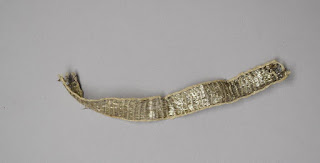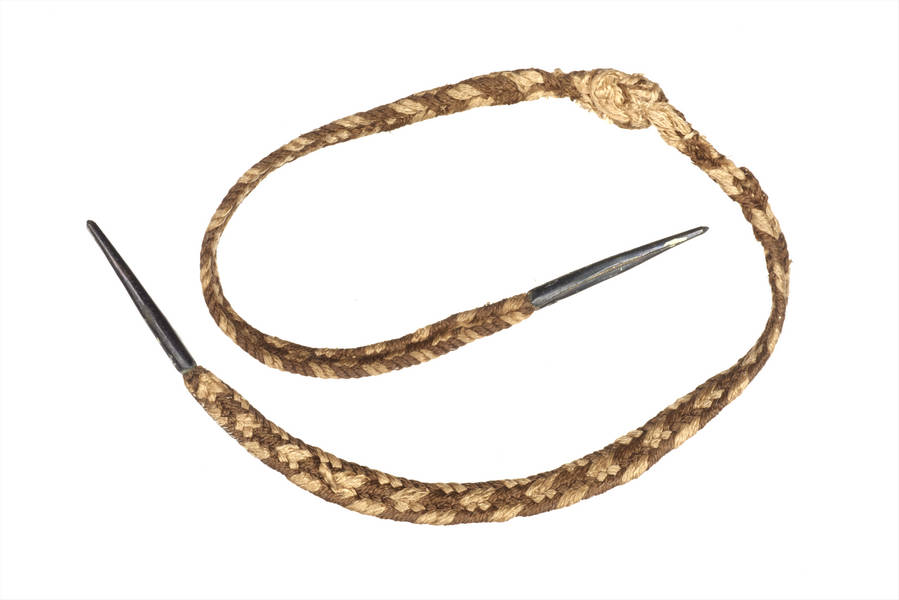Nicholas LeStrange (1605-1655) of Hunstanton, Norfolk, was the eldest surviving son of Sir Hamon LeStrange. In 1629, his father purchased a baronetcy for him at a cost of £300, plus £100 in charges. The following year Nicholas married Anne (1612–1663), daughter of Sir Edward Lewkenor of Denham, West Suffolk. The LeStrange accounts include the purchase in London of three suits of clothes with accessories, for the wedding. (Whittle & Griffiths, 2012) The total bill came to £161 12s 1d.
The suits
The tailor’s bill for making the three suits and a coat came to £18 16s 0d. The first suit was pearl coloured satin for the suit and cloak, the suit was lined with carnation satin, and the cloak with carnation plush. Plush was a long-napped fabric often used for warm linings., it is the most expensive fabric used at over £1 7s a yard. The suit was decorated with silver bone lace edging and chain plate lace weighting 21 ounces. Metallic laces were usually listed by weight, rather than length, as the value was in the metal used. There is a slightly later metallic lace border in the Victoria and Albert Museum, which they describe as a chain lace, the thread is copper-gilt wound on a yellow silk core, but the use of the term chain plate may indicate that this is more of a braid like lace, as in this silver example, also in the V&A.
 |
| Figure 1: Silver braid. Victoria and Albert Museum |
The second suit was a doublet and hose [breeches] of fine Spanish cloth, which cost £1 2s 0d a yard. Spanish cloth did not come from Spain, it was produced in the West country, and anyone wanting further information should look at Hugh Chevis’s thesis. (Chevis, 2017) This suit appears to have been provided with a coat, rather than a cloak. The coat was of Turkey camlet, which was a considerably cheaper fabric than the Spanish cloth, being only 8s 6d the yard. The composition of camlet varies according to date, as Dr Johnson says it was, “A kind of stuff originally made by a mixture of silk and camel's hair; it is now made with wool and silk.” (Johnson, 1755) The suit and coat were decorated with gold and silver lace weighing 35 ounces, at a cost of £8 15s.
The third suit was of “best scarlet,” it needs to be pointed out that scarlet was a wool fabric and not necessarily the colour, though many scarlets were red. The edging and lining of the suit was crimson satin, and the cloak to it was lined with peal coloured plush.
The total cost of the fabric and lace for the three suits and coat was £87 6s 5d.
The Accessories
Neck and wrist wear
Nicholas purchased a variety of styles of neckwear. There was a ruff and a pair of cuffs at £1 10s, a falling band and band strings at £1 6s, a further three falling bands and six pair of Flanders strings. There were two cloth work laced bands, which were starched and were more expensive at £5 17s 6d for the two. Band strings could be very decorative as in this example attached to a ruff in the Manchester collection.
| Figure 2: Ruff and band strings. Manchester Art Gallery |
Stockings
Nicholas only buys one pair of silk stockings at £1 12s. This is an average price for silk stockings, the Earl of Bath’s accounts show silk stockings costing between £1 a pair and £2 10s for “green silk stockings for my Lord.” (Gray, 1996) Historic Royal Palaces has a vibrant pair of green silk stockings that belonged to William III. Nicholas also buys a pair of garters to hold up his stockings at a cost of £4.
Footwear
The footwear consists of two pair of boots, for £1 3s 6d, an to go with them a pair of spurs for 2s 6d. There is also a pair of pumps and a pair of white shoes. There is a surviving pair of white shoes dating to about 1600 in the Ashmolean Museum, and another pair from about 1640 in the Livrustkammaren. Pumps are shoes for dancing, or as Randle Holme describes them, “Pumps are shooes with single soles and no heels,” a writer in the sixteenth century describes them as not being fastened with latchets. For the shoes there shoe roses costing 22 shillings.
| Figure 3. White leather shoes. Livrustkammaren, Stockholm. |
Hats
Nicholas purchases a black beaver hat, dressed and lined for £2 18s, and a silver hat band for 7s 6d. A further beaver hat is purchased with a band for £3 14s. Beaver is the most expensive type of hat, an ordinary felt would only have been around 2s 6d. (Spufford & Mee, 2017, p. 30) Hats were frequently lined both in the crown and the brim.
Gloves
He purchases eight pairs of gloves, three white, three of cordovan leather and two other pairs.
Girdles and points
Points are what hold the breeches and doublet together. Nicholas purchases three sets, each of 20 points; gold and silver, crimson and silver and scarlet and silver, for between £1 5s and £1 10s a set. There is a rare survival of a silk point with its aiglets intact in the Museum of London. He also purchases a silver girdle and a gold and silver girdle, girdles were worn around the waist, and there is a 1620s example in the Victoria and Albert Museum.
 |
| Figure 4. Silk point with metal aiglet. Museum of London |
A waistcoat
The last garment to mention is that he purchases a silver and gold waistcoat for £5 13s. Waistcoats worn under doublets could be knitted, and there are several survivals that incorporate metallic threads, for instance the green and gold “hunting jacket” in the Cleveland Museum.
| Figure 5. Green knitted waistcoat. Cleveland Museum. |
Jewellery
To accompany his outfits Nicholas purchases a diamond ring and earring at a total cost of £16 12s 6d.
A comment on prices
To put the price of Nicholas’s outfits into some form of context, his total bill is £161 12s 1d. Nicholas and his father employ around 40 staff, some are paid annually, but have their board and lodging free. Of these their cook receives £5 a year, the gardener £4 and the coachman £3, in addition to board and lodging they also get a livery a piece of 8 shillings. Below these the dairymaid receives £2 a year and the backhouse maid £1 10s.
References
Chevis, H. (2017). Innovations in Cloth Manufacture in Early Modern England: The Demise of English Fine Wools and Rise of Spanish Merino Wool. PhD thesis. University of Western Australia. https://api.research-repository.uwa.edu.au/ws/portalfiles/portal/26474580/THESIS_DOCTOR_OF_PHILOSOPHY_CHEVIS_Hugh_William_2017.pdf.
Gray, T. (1996). Devon Household Accounts 1627-59. Part 2 . Exeter: Devon and Cornwall Record Society, new series, vol. 39.
Johnson, S. (1755). A Dictionary of the English Language. Retrieved Jun 28, 2023, from https://johnsonsdictionaryonline.com
Spufford, M., & Mee, S. (2017). The Clothing of the Common Sort 1570-1700. Oxford: OUP.
Whittle, J., & Griffiths, E. (2012). Consumption and Gender in the Early Seventeenth Century Household. Oxford: OUP.